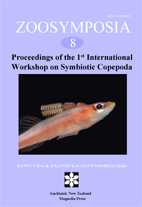Abstract
Currently, many fish parasites have been dispersed worldwide via the movement of fishes for food, sport, or the aquarium trade. The freshwater parasitic copepod Neoergasilus japonicus (Harada, 1930) is such an example: it is native to eastern Asia, but has been introduced to southern Asia, Europe, and North America. Since N. japonicus has been regarded as an important alien parasite in such regions, more information is needed on the ecology and host-parasite relationships of this species. In this study, specimens of N. japonicus were collected from the following seven alien freshwater fishes on Okinawa-jima Island, southern Japan: redbelly tilapia (Tilapia zillii), Mozambique tilapia (Oreochromis mossambicus), and Nile tilapia (O. niloticus niloticus) (Perciformes: Cichlidae); bluegill (Lepomis macrochirus) (Perciformes: Centrarchidae); Indian glassy fish (Pseudambassis ranga) (Perciformes: Ambassidae); mosquitofish (Gambusia affinis) (Cyprinodontiformes: Poeciliidae); and vermiculated sailfin catfish (Pterygoplichthys disjunctivus) (Siluriformes: Loricariidae). Copepods occurred on alien fishes taken from reservoirs, but were absent on those from rivers. The dorsal fin was most heavily infected, followed by the anal fin, gills, and body surface. The native freshwater fishes in our sampling locations have been replaced by alien fishes that were introduced from various regions of the world. Our results therefore showed that this low host-specific species can persist by utilizing alien fishes as hosts even after the native fishes have either disappeared or greatly decreased in abundance. A list is also given of fishes (88 species and 3 subspecies in 7 orders and 16 families) reported as hosts of N. japonicus.

